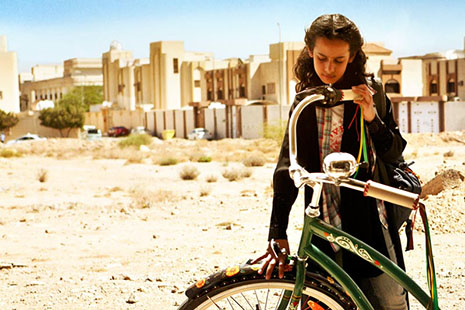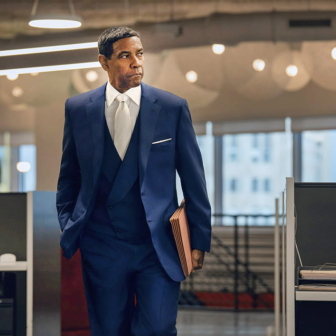THERE was a sharp irony in the opening of the 2013 Sydney Film Festival on the evening of 5 June, a classy, glitzy, dressed-up event exhibiting conventional glamour, with red carpet entry, bright lights and roped-off walkway for important and well-recognised persons: the sort of first-night event you might expect for, say, The Great Gatsby. But then, as a first-night special, in Ivan Sen’s Mystery Road – a miraculous latter-day Western with a police-procedural twined into it – we got the kind of cinema that subverts everything red carpets are about.
This film is to reach the commercial circuit in mid August; I’ll try to do it some critical justice then. For the present, it is perhaps enough to say that Sen has taken off from the High Noon sort of Western, the isolation of the principled gunman who alone knows the enemy’s objectives and devices. At the same time, in the film’s cop-show aspect, Aaron Pedersen’s Jay Swan inherits Bogart’s Marlowe in a Raymond Chandler plot. “Down these mean streets a man must go...” It’s something new to have the mean streets replaced by dusty back-country roads, a depressed small town of squalid, neglected houses, overgrown yards and endless flat horizons; and the man, “who is not himself mean,” is an Aboriginal Australian. Socially and atmospherically, he’s in a fictional place not too far from the Toomelah of Sen’s last feature film; fictional, and also intensely real.
To that place and that film, I hope to return. On from the opening, the festival burgeoned into 192 films playing on six, sometimes seven screens; the program is a tantalising network of clashes and overlaps – and that’s no criticism of the programmers, great jugglers that they are. From the score of films within one viewer’s limited compass, I comment here on those I and others enjoyed the most; many of these, happily, are booked with major distributors and are therefore likely to reach accessible outlets. One of those is Asghar Farhadi’s The Past, much anticipated after last year’s superb A Separation; another is Haifaa Al Mansour’s Wadjda, which should have got a prize for its courage, both within its depicted story and outside the frame. It comes from Saudi Arabia, where the cinema is forbidden, and where women are denied places in the public world. Al Mansour, once a student of film in Sydney, told us how she had to direct action from inside a van, using a microphone, in places where she could not be seen at work on the street. Nor can girls or women be seen riding bicycles; therefore the ten-year-old Wadjda, already swathed in black, wants nothing more than her bike and the freedom to ride it. The best thing about this fluent, lively film is that it loses nothing in symbolic resonance for its close grip on a particular Middle Eastern story. Rebellious girls, Al Mansour believes, are among the major agents of history; and even there, in a regime her Western audiences find intolerably and incomprehensibly repressive, she and her cast communicate joy in the struggle. Wadjda is a treat; it was wildly popular with the festival audiences, and people came out predicting – wrongly – that it was set for the Sydney Film Prize.
The festival is always virtual travel, and not only to other physical geographies; we are also taken into realms of poverty and destitution well outside ordinary Australian knowledge. It’s somewhat as though these audiences were known to be privileged, known to be in need of excursions outside their comfort zones. But whatever virtue there is in looking at images of the shelterless and hungry, they won’t work to extend understanding unless the film has clarity, structure, organised energy, direction working with performance. I saw some rather bad examples; White Elephant wanders an Argentinian shanty-town, where two priests and a beautiful social worker try to do some good, but the utter conventionality of the love story reduces the significance of the milieu. That contrasted with the more vivid and effective probing of community in Mahamet-Saleh Haroun’s marvellous Grigris. The French cinema goes – one might think compulsively – to Francophone north Africa, to the former colonies and so to places where the secular Western world meets other faiths and customs. Here, in French and Arabic, we follow a lithe but crippled Chadian dancer (Souleyman Démé) into night-club success, family troubles, dangerous entanglements; he is a stumbling innocent at large. If he’s to be rescued from disaster, it will be because of a community around him; in this case, it’s a vivid, raucous, defiant band of women. Again, and to its benefit, the French feature film inherits ethnography, in a line of descent going back to the great Jean Rouch.
Wadjda and Grigris were two of the twelve features in competition. The one Australian entry in that list was The Rocket, with which the producer Sylvia Wilczynski and director Kim Mordaunt go back to Laos, where they made the documentary Bomb Harvest in 2007. Their commitment to place and people shows; this too is both ethnography and drama, and like Wadjda centred on a child’s ambition, projected against the fates. Ahlo is a surviving twin, and therefore perceived as accursed; we’re necessarily on his side from the outset to the fine, elating finish. We’re also kept conscious also that the fictional story has strong connections with present tough Laotian realities. There was therefore huge applause when the producer announced from the platform that a fund is being set up for the continued education of the gifted young actors in the film. (Nerves were touched elsewhere as we thought of other films, set in other parts of the planet: what happens on a provincial location when the high intensity of the shoot dissipates, the temporary jobs cut out and the caravan rolls on?)
The competition list included one documentary, the bizarre and demanding The Act of Killing. Directed by Joshua Oppenheimer, with input from Danish, Norwegian and British sources and a long list of co-workers all named Anonymous, this is centred on Anwar Congo, an amazingly insouciant member of the Indonesian death squads of the mid 1960s. Around his unrepentant recollections there’s a messy, piled-up sequence of re-enactments, Hollywood mimicry with dancing girls lined up, confessions in dark spaces, blood and gore in the jungle – everything except the transmission of history which seemed to be promised. You don’t forget Anwar, but that story of which his deeds were part has been too much buried in the general knowledge of our region; with this ambitious but incoherent filmic conglomerate, it’s buried all over again.
This year’s great documentary was Nicolas Philibert’s La Maison de la Radio, in which the director ofEtre et Avoir (To Be and to Have, 2002) among others, follows the personnel and production-work of the major national broadcaster France Inter through almost twenty-four hours. That’s like tracking Fran Kelly, Eleanor Hall, Phillip Adams and the cohorts of workers around them from Radio National Breakfast to the closing words and notes of Late Night Live; I can only wonder whether the ABC would allow a film-maker this kind of access. In a masterly weaving of strands, Philibert lets the personalities of producers, conductors, presenters, musicians and minor performers develop, unforced, before us. The minor crises of any media day erupt, unfold, subside; news items claim headline status and lose it; energies gather and dissolve. There is a palpable, calm generosity on each side of the camera; the director and his team, with all those radio journalists and technicians, share the double task – getting on with their usual work and at the same time making this film.
Is documentary an adequate word for it? The director Sophie Fiennes and the irrepressible philosopher-comedian Slavoj Zizek together gave us a sequel to The Pervert’s Guide to the Cinema (2006). The Pervert’s Guide to Ideology is every bit as enjoyable, with, as we might expect from Zizek, a good many stings in his free-swinging tail. The film is at once wildly funny and horrific; at its end (in which Zizek the cinephile brilliantly mocks the close of Titanic) the complacent Western left-liberal cinephile gets away with nothing; she will emerge from the cinema with intensified discomfort for the mendicant homeless with their cardboard-printed pleas, the beggars on their upturned milk-crates, and all the uncollected rubbish along the nasty end of George Street.
AT A PREVIEW before the festival, I watched the Danish director Nicholas Winding Refn’s Only God Forgives, which unfolds ponderously in a red-lit Bangkok club interior. This film, concerned with murder, revenge and mysterious kinds of gangland criminality, grinds and groans with pseudo-significance; Ryan Gosling fails to give the tale a believable centre, while Kristin Scott Thomas, garishly blonded, is supposed to embody maternal power and purpose. When she gets hers, not even the prosthetics of gore are credible. It’s a long ninety minutes, and I wouldn’t have written a word on this work if it weren’t that – somehow, absurdly and incomprehensibly – it was awarded the Sydney Film Prize. That decision discredits this important contest, the festival and the city. Well may they say that only God forgives; I for one will not.
More on the festival’s offerings soon, and on debates around The Great Gatsby – the movie, that is. Do read, or re-read the book; it’s wonderful. •





